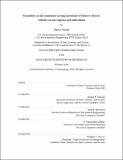Variability in the emissions savings potential of battery electric vehicles across regions and individuals
Author(s)
Miotti, Marco,Ph. D.Massachusetts Institute of Technology.
Download1223505360-MIT.pdf (21.83Mb)
Other Contributors
Massachusetts Institute of Technology. Institute for Data, Systems, and Society.
Advisor
Jessika E. Trancik and John B. Heywood.
Terms of use
Metadata
Show full item recordAbstract
Personal vehicles account for almost 25% of U.S. greenhouse gas emissions, and this share is increasing. The increase is due to several factors, including a growth in transportation demand and the decarbonization of electricity by 30% since 2007. Alternative technologies for road vehicles, such as battery electric, plug-in hybrid, and fuel cell powertrains have the potential to achieve significant emission reductions. Yet questions remain about the emissions and costs of these alternative technologies. This thesis evaluates the emissions reduction potential of vehicles with electrified powertrains, focusing on battery electric vehicles (BEVs). It evaluates this potential taking into account heterogeneous regional conditions and consumer behavior. Consumers help determine vehicle fleet emissions through their purchasing and driving decisions, which are guided in part by the costs of different options. Therefore, the costs of ownership of BEVs in comparison to conventional vehicles inform the emissions reduction potential of BEVs. Here, we measure the lifecycle greenhouse gas emissions and costs of ownership of BEVs across different vehicle models as a function of travel patterns, driving styles, and properties of the natural, built, and institutional environment. We compare these costs and emissions to gasoline combustion engine vehicles (ICEVs), and then ask whether and under which condition electric vehicle adoption can play a central role in meeting emission targets for the transportation sector. The current literature does not cover all the interdependent sources of variation in the emissions and costs of BEVs compared to ICEVs. In particular, the effects of annual travel distance and fuel efficiency related to individual travel behavior and the wide variety of available vehicle models have not been assessed. In addition, this variation in emissions and costs of personal vehicles has only been studied across regions, but not across individual vehicles within each region due to vehicle-specific driving patterns. This work addresses these gaps by developing several interlinked models. This includes the construction of a parametrized lifecycle emissions and cost of ownership model (Chapter 2), an algorithm to measure driving style linked to a vehicle energy model (Chapter 3), and a model to quantify the variability in annual travel distance and fuel consumption of different types of vehicles across regions within the United States, encoded as zipcodes, and across individual vehicles within those zipcodes (Chapter 4). Chapter 5 then ties Chapters 2 and 4 together and complements them with additional information to assess the overall heterogeneity in the emissions reduction potential of BEVs. The central results of the thesis are threefold. First, a rapid decarbonization of electricity in conjunction with an electrification of powertrains will likely be required to meet emission targets for the U.S. transportation sector. Measures that relate to heterogeneous consumer behavior, such as improving driving style and nudging consumers towards purchasing smaller vehicles, can help to reduce greenhouse gas emissions. Second, the electrification of powertrains can come at little to no additional expense to consumers with today's technology and prices. In most parts of the country, BEVs are substantially cheaper than comparable ICEVs. Within regions, the individuals for which BEVs offer the greatest emissions savings would also tend to experience the largest cost savings, since both emissions savings and cost savings are correlated with annual travel distance. Third, emission reductions achieved by BEVs and their costs relative to ICEVs are highly heterogeneous. The within-region variation in emissions and costs of BEVs compared to ICEVs due to individual driving patterns is at least as large as the variation across regional averages. As a result, a 10% share of BEVs in the fleet can lead to anywhere between 1% and 10% emission reductions, depending on which types of vehicles are being replaced by electric vehicles, by whom, and where. A key application of this work is to inform tools that provide localized and personalized information about the environmental and economic performance of different vehicle models. In Chapter 6, we discuss such a tool that was built as part of this work, called Carboncounter.com. Results from a survey launched on Carboncounter add to existing evidence that providing such information to consumers can help inform a transition to a cleaner light-duty vehicle fleet. These findings further confirm the importance of understanding heterogeneous human behaviors to inform decarbonization strategies for personal transport.
Description
Thesis: Ph. D. in Engineering Systems, Massachusetts Institute of Technology, School of Engineering, Institute for Data, Systems, and Society, February, 2020 Cataloged from student-submitted PDF version of thesis. Includes bibliographical references (pages 219-232).
Date issued
2020Department
Massachusetts Institute of Technology. Institute for Data, Systems, and Society; Massachusetts Institute of Technology. Engineering Systems DivisionPublisher
Massachusetts Institute of Technology
Keywords
Institute for Data, Systems, and Society.